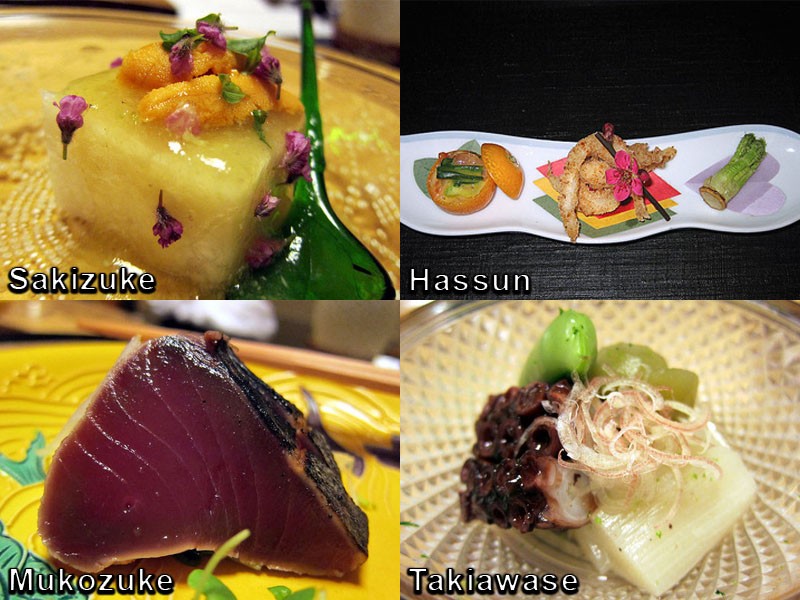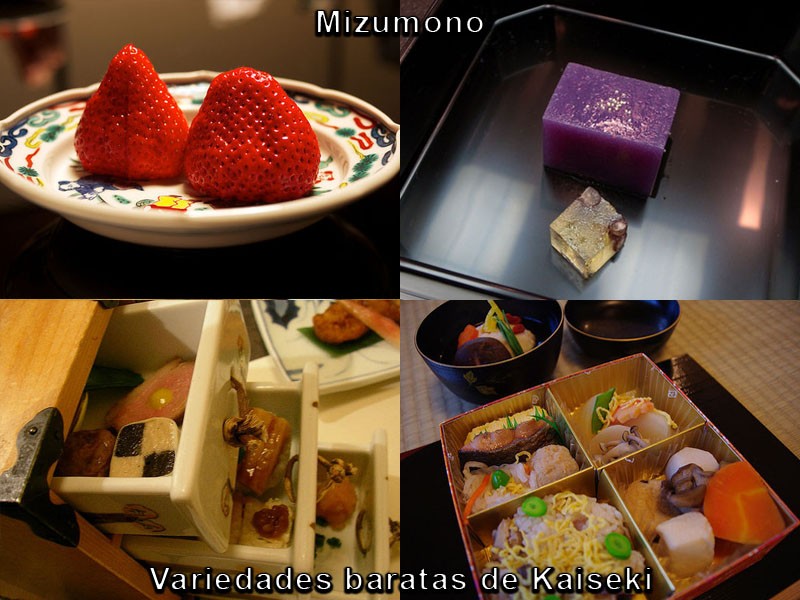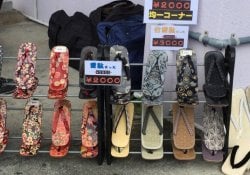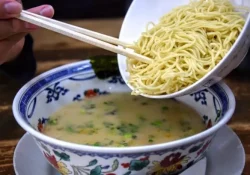Japanese Kaiseki cuisine is known for its meticulous preparation and beautiful presentation. It is also one of the most expensive Japanese meals. Kaiseki restaurants often offer a private room – often overlooking a Japanese garden.
In the old days Kaiseki was a simple banquet served to monks that began to gain fame in the tea ceremony that ended up turning into a sophisticated banquet consisting of several dishes served in several portions.
There are no rules regarding food, but there is all that Japanese aesthetic. And these meals are usually divided into up to 14 types of dishes that we will see below:
Read also:
- The 100 most popular Japanese meals in Japan
- List of 100 Japanese Sweets
- Unagi - Freshwater eel in Japanese cuisine
Índice de Conteúdo
The Origin and History of Kaiseki
The origin of Kaiseki dates back to the 16th century, when Zen monks in Japan began serving simple meals to visitors in their temples. These meals consisted of simple dishes such as boiled rice, vegetables and tea. Over time, these meals improved and became more and more sophisticated, including finely prepared and presented dishes.
Kaiseki is a culinary art form that values simplicity, quality ingredients and elegant presentation. The word “Kaiseki” refers to a formal, traditional Japanese meal, which typically includes a series of dishes that are delicately prepared and presented in a specific order. Each dish is designed to please not only the palate but also the eye, and is carefully selected to pair with the other dishes in the meal.
Kaiseki is often compared to French haute cuisine, but with an emphasis on simplicity and the presentation of natural ingredients. It is a dining experience that can be enjoyed in a formal setting, such as a specialty Kaiseki restaurant, or in a more informal setting, such as a traditional Japanese inn, known as a ryokan.
dishes of Kaiseki
Sakizuke (先附): It is a small dish that is served at the beginning of the meal to whet the appetite and welcome guests. It is usually made up of one or two bites of food, such as a piece of sashimi or a small salad.
Hassun (八寸): is a starter dish consisting of a wooden or ceramic tray with an assortment of small plates that feature seasonal and local ingredients. Dishes can include fish, meat, vegetables, rice and other items.
Mukōzuke (向付): it is a sashimi dish that is usually served after hassun. It consists of thin slices of raw fish, such as tuna or salmon, and is often garnished with edible herbs or flowers.
Takiawase: is a dish that features vegetables and fish cooked together. The ingredients are usually cut into small sizes and carefully laid out on a plate.
Futamono: is a soup that can include a variety of ingredients, such as fish, tofu or vegetables. The soup is usually served in a lidded dish and is elegantly presented.
Yakimono (焼物): Grilled or pan-fried dishes. it is a grilled dish, like fish or meat. The dish is usually seasoned with soy sauce or other seasonings to bring out the natural flavor of the ingredients.
Su-zakana (酢肴): is a dish that features pickled fish. Fish is usually marinated in vinegar and seasoned with salt and sugar to create a sweet and sour taste.
Shiizakana (強肴): Usually a pan with a hot plate. To satisfy your appetite, or to stimulate a little more sake, this mixture can be based on vegetables and nerimono (fish-based pasta, such as kamaboko, chikuwa, hanpen, etc.)
Gohan (御飯): it is boiled rice, usually served with miso and other side dishes. Rice is generally of high quality and is considered an important part of a Kaiseki meal.
Kō no mono (香の物): it is a fruit or dessert that is served at the end of the meal. It is usually a light and refreshing dessert such as fresh fruit or ice cream.
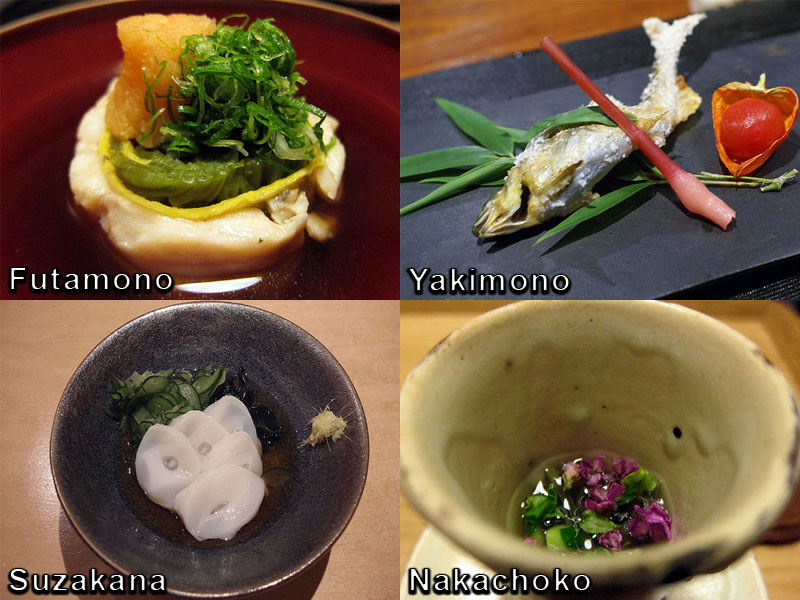
Tome-wan (止椀): it is a thicker soup than Futamono and is usually served in a small plate or bowl.
Taki-gohan (焚きご飯): is a rice dish cooked in a hot broth, usually made from seafood and vegetables.
Mizumono (水物): it is a light dessert, usually composed of fresh fruit, gelatin or ice cream.
Kaiseki ryori (懐石料理): The general name that refers to the entire set of Kaiseki dishes, which can vary according to the chef or the season.
Naka-choko (中猪口): it is a cleansing soup or light broth, served after the main course and before dessert.
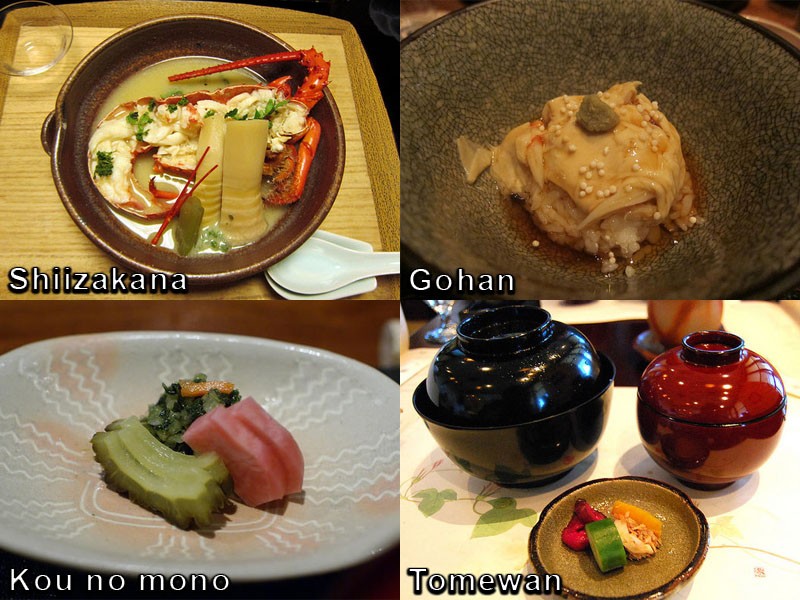
Meal: it is the last part of the Kaiseki meal, where boiled rice, miso soup and other simple side dishes are served to ensure that guests finish the meal completely satisfied.
Omogashi-koicha (主菓子-濃茶): Candy and Tea.
Each of these dishes is designed to provide a unique and authentic dining experience, combining fresh, high-quality ingredients, elegant presentation and meticulous preparation.
There are also other dishes not mentioned, which are usually served in tea ceremonies and not in restaurants.
How much does a Kaiseki Meal cost?
The price of a Kaiseki meal can vary greatly depending on the restaurant you choose and the number of dishes included in the meal. Some high-end restaurants can charge hundreds or even thousands of dollars per person for a full Kaiseki meal, while other restaurants may have more affordable prices.
On average, a Kaiseki meal can cost between US$ 50 and US$ 300 per person, but again, this can vary greatly depending on the restaurant. If you are interested in experiencing a Kaiseki meal, it is recommended that you do some careful research and book in advance to ensure you can enjoy the full experience.
We also recommend reading:
- O Bento – Japanese Lunchboxes – The Art of Cooking
- Ryokan - The charming Japanese inns
- 18 Wagashi – Japanese desserts
Cheap varieties of Kaiseki
Sometimes you can find promotions and offers at lunch or dinner, which go up to the price of 3,000 to 10,000 円 per person. (75 to 210 USD.)
Some restaurants also sell lunch boxes priced between 3,000 to 6,000 円 per person. (75 to 150R$)
There are also regular restaurants that sell kaiseki, they don't offer private rooms, and they bring all the food at once in boxes. They usually cost between 6,000 to 15,000 円 (150 to 380 Reais.)
Ryoukan inns also often offer a small kaiseki during your stay.
The article is still halfway through, but we recommend also reading:
The Best Kaiseki Restaurants
With the rise in popularity of Japanese cuisine around the world, many high-quality Kaiseki restaurants have sprung up in various western cities. Here are some examples of popular Kaiseki establishments in the West and Japan:
N/Naka - Los Angeles, USA: N/Naka is a Kaiseki restaurant located in Los Angeles, run by chef Niki Nakayama. The restaurant offers a personalized tasting experience with seasonal dishes inspired by Kaiseki cuisine, featuring local ingredients and Japanese cooking techniques.
Kikunoi - Kyoto, Japan: Kikunoi is a Kaiseki restaurant established in Kyoto, Japan since 1912. Chef Yoshihiro Murata is known for his skills in preparing classic Kaiseki dishes using fresh, high quality local ingredients.
RyuGin - Tokyo, Japan and Hong Kong: RyuGin is a Kaiseki restaurant located in Tokyo, Japan, which also has a location in Hong Kong. Chef Seiji Yamamoto is known for his ability to transform natural ingredients into delicate and beautiful dishes with complex flavors and textures.
Shigeyoshi - Japan: Shigeyoshi is a small Kaiseki restaurant located in Tokyo, run by chef Kenzo Sato. The restaurant offers a unique and personalized dining experience using fresh, seasonal ingredients in traditional Kaiseki dishes.
Kitcho - Osaka, Japan: Kitcho is a Kaiseki restaurant in Osaka, Japan, run by chef Kunio Tokuoka. The restaurant is known for its emphasis on high-quality ingredients, as well as its elegant presentation of Kaiseki dishes.
- Kaiseki Room by Yamada - New York, USA
- Kaiseki Yuzu - Las Vegas, USA:
- Kaiseki Saryo Hachi - Burlingame, CA, USA
- Kaiseki Sanga - Las Vegas, USA

